NANTWICH
The Town Centre
Grid Ref: SJ 652 523
9 July & 24 September 2005 & 21 Jul 2008
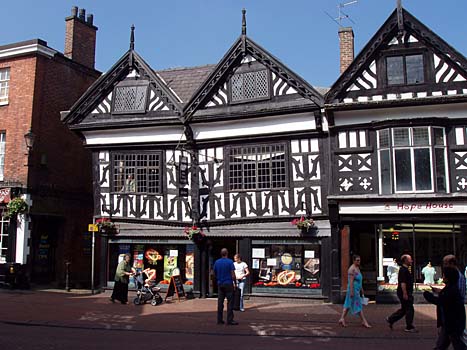 |
|
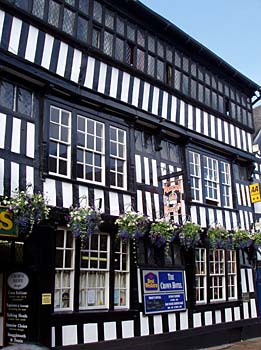 |
| 46 & 48 High Street |
|
Crown Hotel |
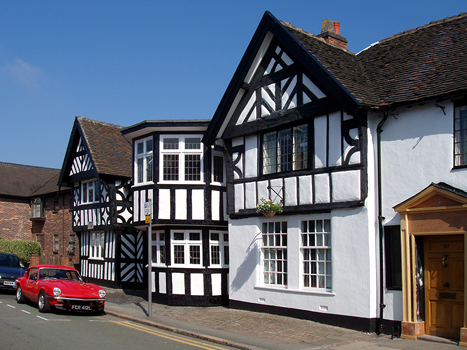 |
|
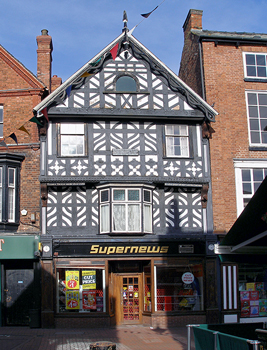 |
| Sweet Briar Hall |
|
41 High Street, 2008 |
 |
|
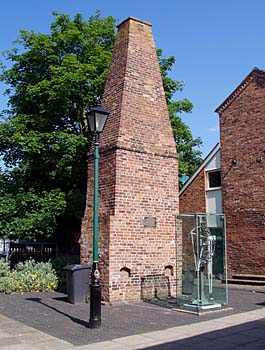 |
| Pillory Street |
|
Forge Chimney |
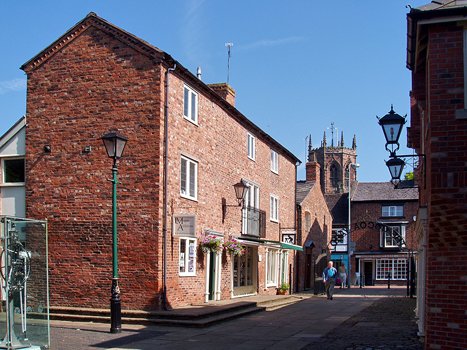 |
|
 |
| The Cocoa Yard |
|
Nantwich Millennium Clock |
 |
|
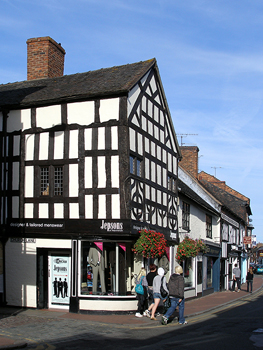 |
| Market Hall |
|
Church Lane |
 |
|
 |
| Welsh Row |
|
Welsh Row |
 |
|
 |
| Widows' Almshouses |
|
Georgian Houses in Welsh Row |
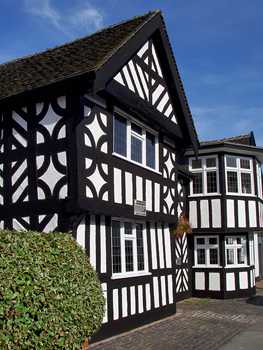 |
|
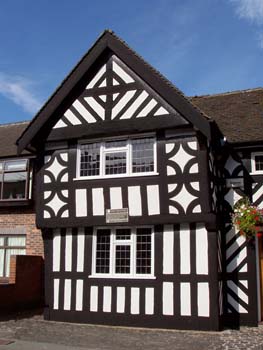 |
| Sweet Briar Hall showing polygonal bay window |
|
Sweet Briar Hall |
I think Nantwich is Cheshire's most interesting historic town;
it is less industrial than Macclesfield and less pretentious than Knutsford with its pseudo-Italian architecture.
It has a large number of historic buildings including some from the Elizabethan
period. Moreover it has a proud history in the Civil War. By holding out against
the Royalist siege until the arrival of General Fairfax, Nantwich helped to
ensure Parliamentary victory in the North West. This victory denied the Royalists
the use of Chester as a port for contact with Wales and Ireland. On this page
I show a few pictures taken near the centre of the town but there is much more
to see, both in the centre and on the outskirts, especially in Welsh Row.
After the Great Fire of Nantwich in 1583, there was extensive
rebuilding, supported by Elizabeth I. Some of these buildings survive. Numbers
46 and 48 High Street were built in 1584 by Thomas Church and William his nephew.
Number 41 High Street, built by Thomas Cleese, has a plaque on which is written:.
"'GOD GRANTE OUR RYAL QUEEN IN ENGLAND LONGE TO RAIGN FOR SHE HATH PUT
HER HELPING HAND TO BILD THIS TOWN AGAIN"
The Crown Hotel was rebuilt soon after the fire. It is timber
framed with continuous glazing on the upper storey. Behind it lies an 18th century
assembly room. Sweet Briar Hall just escaped the fire, which reached adjacent
properties. It was built in the late 15th century and the octagonal bay was
added in the 16th century. Joseph Priestley, a Unitarian Minister and the scientist
who discovered oxygen, lived in this house from 1758-1761. (picture
of statue in Birmingham).
In the Cocoa Yard is a chimney that survives from an 19th century
wheelwright's forge and smithy. The forge made parts for horse-drawn coaches,
built in Welch's Coach Manufactory. Dysart Buildings in Monks lane is a brick
terrace of nine bays.
The Market Hall was built in 1867 by the architect George Latham.
It cost £2,000 and was built on land given by John Tollemache, MP. Above
the door are the arms of three of the local landed gentry families, Cholmondeley,
Tollemache and Malbedeng. The latter is the most ancient. William Malbedeng,
in the early Norman period was granted about three quarters of the land in the
Nantwich Hundred, including Nantwich and its salt-works, and the Hundred Court
of Warmundestrou. His holding included among other places some villages included
on these pages such as Acton, Wrenbury, Marbury and Barthomley. In the remaining
part of the Hundred of Nantwich the land holders were Richard Vernon, who held
Audlem and Crewe; Gilbert de Venables, who had Blakenhall, and the bishop of
Lichfield, who had Wybunbury. In ancient documents, Nanwich is called Wich Malbank
or Wicus Malbanus, taking this name from William Malbedeng, sometimes written
as Malbanc.
John Gerard, author of Gerard's Herbal was born in Nantwich.
After travelling abroad he settled in London. He had his own garden in Holborn
and became the gardener for Lord Burghley, chief minister of Elizabeth I. Gerard's
book on herbs is a mixture of botany and astrology. He believed that parts of
the body fell under the influence of various planets and stars and must be treated
by plants which were influenced by complementary heavenly bodies.
The Widows Almshouses were built in the early 17th century as cottages and converted by Sir Roger Wilbraham into almshouses for six widows in 1676
Sources
Plaques erected by Nantwich Civic Society
Arthur Mee's Cheshire, published by Hodder and Stoughton, London, 1938;
fourth impression 1950.
The Buildings of England, Cheshire, by Nikolaus Pevsner and Edward Hubbard,
Yale University Press, 2003, ISBN 0 300 09588 0
The History of the County Palatine and City of Chester,
incorporated with a republication of King's Vale Royal and Leycester's Cheshire
Antiquities, 2nd Ed., revised and enlarged by Thomas Helsby, Esq., published
by George Routledge and sons, Ludgate Hill, London, 1882. This is now available
from the Family History Society of Cheshire on CD ROM. A reprint of the work
was published by Eric Morten of Didsbury.
Nantwich Page 1: The Church of St. Mary
Nantwich Page 2: Holly Holy Day















